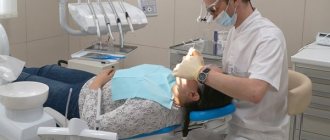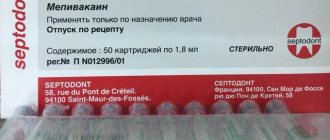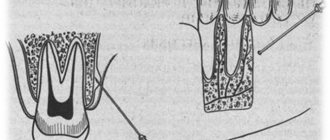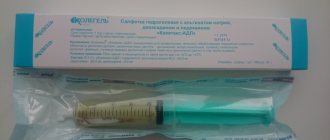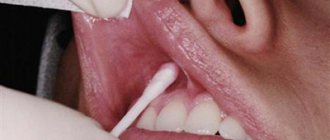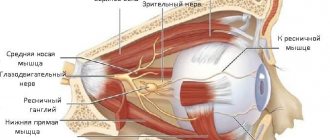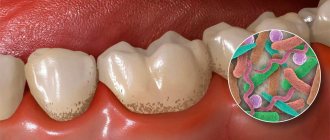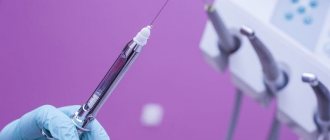Pharmacological properties of the drug Mepivacaine
Local anesthetic of medium duration of action of the amide group. Causes a reversible block of nerve conduction by reducing the permeability of neuron membranes to sodium ions. Compared with lidocaine, mepivacaine causes less vasodilation and has a more rapid onset and longer duration of action. Systemic absorption of mepivacaine depends on the dose, concentration, route of administration, degree of tissue vascularization, and degree of vasodilation. When anesthetizing the teeth of the upper and lower jaw, the effect develops after 0.5–2 and 1–4 minutes, respectively. Dental pulp anesthesia lasts for 10–17 minutes; soft tissue anesthesia in adults lasts 60–100 minutes. When administered epidurally, the effect of mepivacaine develops after 7-15 minutes, the duration of action is 115-150 minutes. Distributed in all tissues, maximum concentrations are created in well-perfused organs, including the liver, lungs, heart and brain. Mepivacaine undergoes rapid metabolism in the liver and is inactivated by hydroxylation and N-demethylation. Three inactive metabolites are known: two phenolic derivatives, which are excreted as glucuronic conjugates, and 2′,6′-pipcolocylide. Approximately 50% of pepivacaine is excreted in the bile as metabolites and undergoes enterohepatic recirculation followed by renal excretion. Only 5–10% is excreted unchanged in urine. A certain amount of the drug is metabolized in the lungs. The metabolism of mepivacaine in newborns is limited; the drug is excreted in unchanged form. The half-life is 1.9–3.2 hours in adults and 8.7–9 hours in newborns. Penetrates the placenta through passive diffusion.
Mepivacaine DF
Overdose is possible due to unintentional intravenous administration of the drug or as a result of extremely rapid absorption of the drug. The critical threshold dose is a concentration of 5-6 mcg of mepivacaine hydrochloride per 1 ml of blood plasma.
Symptoms:
1. From the central nervous system
Mild intoxication - paresthesia and numbness of the mouth, tinnitus, “metallic” taste in the mouth, fear, anxiety, tremor, muscle twitching, vomiting, disorientation.
Moderate intoxication - dizziness, nausea, vomiting, speech disorder, stupor, drowsiness, confusion, tremor, choreiform movements, tonic-clonic convulsions, dilated pupils, rapid breathing.
Severe intoxication - vomiting (risk of suffocation), sphincter paralysis, loss of muscle tone, lack of reaction and akinesia (stupor), irregular breathing, respiratory arrest, coma, death.
2. From the heart and blood vessels
Mild intoxication - increased blood pressure, rapid heartbeat, rapid breathing.
Moderate intoxication - rapid heartbeat, arrhythmia, hypoxia, pallor. Severe intoxication - severe hypoxia, cardiac arrhythmia (bradycardia, decreased blood pressure, primary heart failure, ventricular fibrillation, asystole).
Treatment:
When the first signs of overdose appear, it is necessary to immediately stop administering the drug, and also provide support for respiratory function, if possible with the use of oxygen, monitoring pulse and blood pressure.
If breathing is impaired - oxygen, endotracheal intubation, artificial ventilation (central analeptics are contraindicated).
In case of hypertension, it is necessary to elevate the patient's upper body, and if necessary, administer nifedipine sublingually.
In case of hypotension, it is necessary to bring the patient’s body position to a horizontal position, and, if necessary, intravascular administration of an electrolyte solution and vasoconstrictor drugs. If necessary, the volume of circulating blood is replaced (for example, with crystalloid solutions).
For bradycardia, atropine (0.5 to 1 mg) is administered intravenously.
In case of convulsions, it is necessary to protect the patient from collateral damage; if necessary, diazepam is administered intravenously (5 to 10 mg). For prolonged convulsions, sodium thiopental (250 mg) and a short-acting muscle relaxant are administered; after intubation, artificial ventilation of the lungs with oxygen is performed.
In case of severe circulatory disorders and shock - intravenous infusion of solutions of electrolytes and plasma substitutes, glucocorticosteroids, albumin.
For severe tachycardia and tachyarrhythmia, use intravenous beta-blockers (selective).
If the heart stops, cardiopulmonary resuscitation must be performed immediately.
When using local anesthetics, it is necessary to provide access to a ventilator, drugs that increase blood pressure, atropine, and anticonvulsants.
Use of the drug Mepivacaine
Infiltration anesthesia: For adults, up to 40 ml of 1% solution (400 mg) or 80 ml of 0.5% solution (400 mg) in divided doses over 90 minutes. For blockade of cervical nerves, brachial plexus, intercostal nerves: Adults - 5–40 ml of 1% solution (50–400 mg) or 5–20 ml of 2% solution (100–400 mg). Paracervical blockade: Adults up to 10 ml of 1% solution on each side. Inject slowly with an interval of 5 minutes between injections on the other side. Peripheral nerve block: Adults 1–5 ml of 1–2% solution (10–100 mg) or 1.8 ml of 3% solution (54 mg). Infiltration anesthesia in dentistry: Adults - 1.8 ml of 3% solution (54 mg). Infiltration is performed slowly with frequent aspiration. In adults, 9 ml (270 mg) of 3% solution is usually sufficient to anesthetize the entire oral cavity. The total dose should not exceed 400 mg. Children: 1.8 ml of 3% solution (54 mg). Infiltration is performed slowly with frequent aspiration. The maximum dose should not exceed 9 ml (270 mg) of 3% solution. Epidural or caudal anesthesia: Adults - 15–30 ml of 1% solution (150–300 mg), 10–25 ml of 1.5% solution (150–375 mg) or 10–20 ml of 2% solution (200–400 mg). Maximum doses: Adults: 400 mg as a single dose for regional administration; the maximum daily dose is 1000 mg. Children: 5–6 mg/kg. For children under 3 years of age or weighing less than 13.6 kg, mepivacaine solutions are used in concentrations up to 2%.
Mepivacain-Binergia
Overdose is possible due to unintentional intravascular administration of the drug or as a result of extremely rapid absorption of the drug. The critical threshold dose is a concentration of 5-6 mcg of mepivacaine hydrochloride per 1 ml of blood plasma.
Symptoms
From the central nervous system
Mild intoxication - paresthesia and numbness of the mouth, tinnitus, “metallic” taste in the mouth, fear, anxiety, tremor, muscle twitching, vomiting, disorientation.
Moderate intoxication - dizziness, nausea, vomiting, speech disorder, stupor, drowsiness, confusion, tremor, choreiform movements, tonic-clonic convulsions, dilated pupils, rapid breathing.
Severe intoxication - vomiting (risk of suffocation), sphincter paralysis, loss of muscle tone, lack of reaction and akinesia (stupor), irregular breathing, respiratory arrest, coma, death.
From the heart and blood vessels
Mild intoxication - increased blood pressure, rapid heartbeat, rapid breathing.
Moderate intoxication - rapid heartbeat, arrhythmia, hypoxia, pallor.
Severe intoxication - severe hypoxia, cardiac arrhythmia (bradycardia, decreased blood pressure, primary heart failure, ventricular fibrillation, asystole).
Treatment
When the first signs of overdose appear, it is necessary to immediately stop administering the drug, and also provide support for respiratory function, if possible with the use of oxygen, monitoring pulse and blood pressure.
If breathing is impaired - oxygen, endotracheal intubation, artificial ventilation (central analeptics are contraindicated).
In case of hypertension, it is necessary to elevate the patient's upper body, and if necessary, administer nifedipine sublingually.
In case of hypotension, it is necessary to bring the patient’s body position to a horizontal position, and, if necessary, intravascular administration of an electrolyte solution and vasoconstrictor drugs. If necessary, the volume of circulating blood is replaced (for example, with crystalloid solutions).
For bradycardia, atropine (0.5 to 1 mg) is administered intravenously.
In case of convulsions, it is necessary to protect the patient from collateral damage; if necessary, diazepam is administered intravenously (5 to 10 mg). For prolonged convulsions, sodium thiopental (250 mg) and a short-acting muscle relaxant are administered; after intubation, artificial ventilation of the lungs with oxygen is performed.
In case of severe circulatory disorders and shock - intravenous infusion of solutions of electrolytes and plasma substitutes, glucocorticosteroids, albumin.
For severe tachycardia and tachyarrhythmia, use intravenous beta-blockers (selective).
If the heart stops, cardiopulmonary resuscitation must be performed immediately.
When using local anesthetics, it is necessary to provide access to a ventilator, drugs that increase blood pressure, atropine, and anticonvulsants.
Drug interactions Mepivacaine
Local anesthetics (especially when prescribed in large doses) may have an antagonistic effect on neuromuscular transmission compared to cholinesterase inhibitors. The use of local anesthetics with ganglion blockers may increase the risk of arterial hypotension and bradycardia. Patients taking MAO inhibitors concomitantly with local anesthetics have an increased risk of developing arterial hypotension. Local anesthetics may have an additive hypotensive effect in patients taking antihypertensive agents and organic nitrates.
List of pharmacies where you can buy Mepivacaine:
- Moscow
- Saint Petersburg
Quantitative determination in the blood of specific immunoglobulins of class E to the local anesthetic - mepivacaine/polocaine, which are markers for the occurrence of allergic reactions to it. Allergy to this drug is rare and can manifest itself in the form of skin rash, itching around the injection site, rhinitis, and in severe cases, angioedema and anaphylactic shock. Determination of specific immunoglobulin E for a given allergen in increased quantities indicates the presence of sensitization of the body to it.
The study is carried out only for type 1 allergic reactions. A negative test result cannot guarantee that you will not have another type of allergic reaction.
Synonyms Russian
Specific immunoglobulins class E for mepivacaine/polocaine.
English synonyms
Allergen c88 – Mepivacaine/Polocaine; IgE.
Research method
Enzyme-linked immunosorbent assay (ELISA).
Units
IU/ml (international unit per milliliter).
What biomaterial can be used for research?
Venous blood.
How to properly prepare for research?
- Do not smoke for 30 minutes before the test.
General information about the study
Mepivacaine/polocaine is an amide-type local anesthetic with a fairly strong and rapid action. It is used to create terminal, infiltration, and conduction anesthesia. When the drug enters the nerve fiber cells, it reversibly blocks the entry of sodium into them, which leads to the cessation of the propagation of the nerve impulse and the absence of pain sensitivity. Mepivacaine is used in dentistry, for tracheal intubation, endoscopic examination methods (bronchoscopy, FGDS). The drug is also known under the trade names Mepivastezin, Mepidont, Isocaine, Scandonest, etc.
One of the possible side effects of the anesthetic is the development of an allergic reaction in susceptible individuals. The allergy develops as an immediate type of hypersensitivity (in a few minutes or hours) and can be manifested by local symptoms: redness, itching, burning at the injection site. Skin rashes in the form of urticaria or allergic dermatitis are possible. With more severe development, signs of allergic rhinitis, rhinoconjunctivitis, and bronchial asthma appear. The most severe manifestations of an allergic reaction are angioedema (Quincke's edema) and anaphylactic shock.
It should be noted that an allergic reaction to mepivacaine/polocaine may be combined with an allergy to other drugs from the group of local anesthetics.
What is the research used for?
- Diagnosis of immediate allergic reactions to mepivaquine/polocaine;
- differential diagnosis of the causes of allergic reactions in children and adults during the use of local anesthetics.
When is the study scheduled?
- When planning local anesthesia using mepivacaine/polocaine in patients with suspected allergies to local anesthetics;
- when examining children and adults with urticaria, itching, allergic rhinitis, conjunctivitis, bronchial asthma, angioedema, anaphylactic shock after the use of local anesthetics.
What do the results mean?
Reference values: 0.00 - 0.35 IU/ml.
Reasons for the positive result:
- immediate hypersensitivity to mepivacaine/polocaine.
Reasons for negative results:
- lack of IgE sensitization to this allergen;
- long-term restriction or exclusion of contact with the allergen.
Interaction with other drugs
Special instructions when using Mepivacaine also include interactions with other drugs. For example, experts recommend stopping the use of MAO inhibitors (monoamine oxidase) at least 10 days before dental treatment with this anesthetic. Otherwise, a decrease in blood pressure may occur.
People taking anticoagulants (for varicose veins, angina pectoris, heart rhythm disturbances) are at risk - because. Bleeding may occur. Mepivacaine hydrochloride also increases the duration of action of muscle relaxants. And when taken simultaneously with antiarrhythmic drugs (for atrial fibrillation, tachycardia, etc.), side effects may be more pronounced.
The product may interact with other drugs
It is important to know! Before dental treatment, you should definitely tell your doctor about what medications you have taken in the last 10-14 days, as well as about your chronic diseases. After all, the patient himself is unlikely to be familiar with the full instructions for using Mepivacaine, and the doctor has thoroughly studied the characteristics of each anesthetic with which he works.
Mepivacaine in dentistry
Mepivacaine hydrochloride has been known since the 60s of the last century. Mepivacaine is now widely used as an anesthetic in dentistry. Specifically, use for local1 anesthesia or “freezing” injections. It is used in the treatment and extraction of teeth, and during more extensive surgical interventions (we will tell you in more detail about the indications a little later). A solution containing 30 mg of mepivacaine hydrochloride is transparent, colorless and odorless. The composition also includes 1 ml of water for injection and 6 mg of sodium chloride (saline). Supplied in 1.8 ml ampoules (cartridges). You cannot purchase it yourself, because... Such substances are dangerous if used unprofessionally and are purchased only by clinics.
The drug has been used since the 60s of the last century
